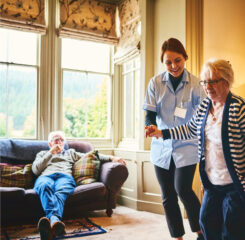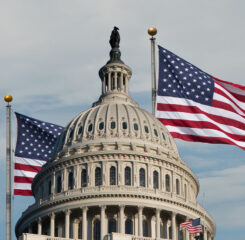CAST Commission Technology Town Hall Meeting Shaped Policy Priorities
A policy discussion at the latest CAST Commission meeting helped shape the 2020 Technology and Telehealth advocacy goals for LeadingAge. During the LeadingAge Annual Meeting, held Oct. 27-30, 2019, in San Diego, CA, the CAST Commission’s Technology Policy Town Hall focused on legislative as well as regulatory challenges of adopting key technologies. The goal of the Town Hall was to identify a robust and inclusive policy agenda for technology in aging services.
The Town Hall was moderated by Mike B. Ambrose, CAST International Vice Chair, and President & CEO, Whitney Center; Ruth Katz, Senior Vice President for Policy, LeadingAge; and Majd Alwan, Senior Vice President of Technology & Business Strategy, LeadingAge.
CAST Commissioners were encouraged to share their thoughts on several of CAST’s core activities, and how they could continue to promote the development of technology policy at both the federal and state levels to advance the use of appropriate aging services technologies in order to transform the aging experience and enhance care for older adults. There was robust discussion relating to technology that can improve the aging experience and facilitate their work – including aging in one’s own home and their community.
There were several discussion points put forward by the moderators that addressed federal policy changes that could facilitate long-term and post-acute care (LTPAC) providers in adopting an electronic health records (EHR) system and exchanging health care data with other providers. They also discussed policy priorities that include “social isolation,” and if there are federal barriers to using technology to do this and changes that the Medicare and Medicaid programs could make to get past barriers to expanding telemedicine, telehealth and remote patient monitoring.
Additionally, the Commission was encouraged to share what policy barriers get in the way of using technology in aging services to the fullest, and the funding mechanisms that are needed to advance adoption of appropriate technologies and expand access in areas designated as rural or populations designated as underserved.
Below are some of the main key takeaways from the CAST Technology Policy Townhall:
- Having Access to Affordable Broadband Internet: Many older adults (especially low income) don’t have access to an affordable high-speed broadband connection. Broadband Technology Opportunities Program (BTOP) grant funds allowed for some participants to work with affordable housing communities across the country. However, having access to a broadband connection in affordable housing communities continues to be an issue. As a result, technology platforms for socialization and health and wellness may not be suitable for locations without a broadband internet connection. As one participant complained, “One of the simplest, but hardest things to solve for is Wi-Fi. So, a lot of buildings just don’t have Wi-Fi, nor do they have funding for Wi-Fi because it’s not affordable or an allowable expense.”
- Adopting an Electronic Health Record System and Making Healthcare Data Interoperable: In spite of not receiving funds that came out of the Meaningful Use program 10 years ago, several participants felt that LTPAC systems are ready. They thought Medicare Advantage could likely be a ticket for implementing models that deploy EHRs for each of the different silos. One participant explained, “Our interoperability problem is not primarily a problem of will, just we need more money to invest in 10 more EHRs. The real problem is how do we get everybody aligned. The government can align this by incenting the delivery. “
- Barriers in Expanding Telehealth and Telemedicine: Make sure payments made through the Medicare and/or Medicaid to get past barriers in expanding telehealth and telemedicine are focused at the person-level, rather than at the encounter level. Another participant emphasized moving more holistically at what we’re doing. As one participant mentioned, “There should be continued advocacy on having a CMMI demonstration of a new payment model from Medicare for LTPAC providers.”
- Raise Awareness and Educate the Importance of Informed Consent to Allow Health Information Exchange: Unless an organization has patient consent to share health information, technology is not going to solve the problem of a Health Information Exchange (HIE). Educating older adults to encourage the senior population to understand what consent means and recognize that it’s for the better of their health, their community, their providers, and their families. As one participant put it, “If you don’t have the patient’s consent, you cannot share. Let’s come together and find a way to educate this population on informed consent.”
- Incentives for Engaging with Health Information Exchange: There should be a financial incentive and requirement to share health information in a timely manner and act on that information. For example, that implies a hospital will share health information in a timely manner and the receiving SNF is using that data. The financial incentive may be part of a Quality Payment Model. Furthermore, long term-care providers should have a reduced (subsidized) subscription fee to engage with a HIE entity. As one participant said, “We’ve got to force the fact that the data is not just being pushed and sitting someplace, and nobody’s looking at it and using it. We’ve got to force the process of interoperability. Until this happens, information’s being moved around, but not used. It’s more than just outputs. There’s a big gap between moving data and getting the outcomes.”
- Federal Barriers to Using Technology to Address Social Isolation: While technology holds a lot of promise for addressing social isolation, ideas that help to overcome some of the barriers should be comprehensive, simple, and affordable. One participant emphasized the importance of joining forces to unleash the voice of an aging population in a tech-timid marketplace on what is reasonable to address social isolation. There needs to be a rallying cry, and we have to tell a story.
- Technology as a Strategic Priority: Many organizations are not prioritizing technology at the level it needs to be. As a result, technology projects are not happening or are delayed. As one participant shared, “Let’s go back a couple of years ago when LeadingAge CAST put together a Strategic IT Planning Whitepaper. Everyone should take that whitepaper and bring it up to the CEO and make sure that the board gets involved with strategic planning for the organization to bring it up to the level that it needs to be brought up to.”
LeadingAge Technology Policy Priorities for 2020
We welcomed the input at this successful Town Hall, which helped the LeadingAge Policy and CAST teams form LeadingAge’s Technology and Telehealth Policy Priorities for 2020. We’d like to take this opportunity to thank the CAST Commissioners and guests who participated in this Technology Policy Town Hall for the conversation and their suggestions.

Most Recommended
October 15, 2025
 Shutdown Week Three: Impact of Ongoing Closure on Affordable Housing
Shutdown Week Three: Impact of Ongoing Closure on Affordable Housing
December 10, 2025
Fiscal Year (FY) Funding 2026
October 07, 2025
Immigrant Workforce Matching Program Brings Workforce Relief
Recently Added
December 23, 2025
 CMS Debuts Models: ACCESS, ELEVATE and LEAD
CMS Debuts Models: ACCESS, ELEVATE and LEAD
December 22, 2025
GAO Report: Ensuring Accessible Healthcare
December 19, 2025
House Moves Forward on Affordable Housing Reforms
December 19, 2025



